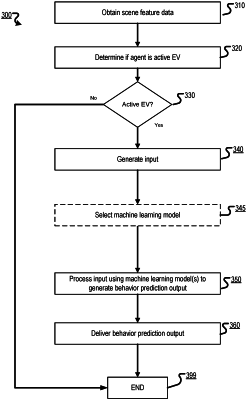| CPC B60W 60/0027 (2020.02) [B60W 50/0097 (2013.01); G05B 13/0265 (2013.01); B60W 2554/4045 (2020.02); B60W 2555/60 (2020.02)] | 17 Claims |

|
1. A method performed by one or more computers, the method comprising:
obtaining scene features of a scene in an environment that includes an autonomous vehicle and a target agent at a current time point;
determining whether the target agent is an emergency vehicle that is active at the current time point;
generating from the scene features, an input (i) that includes the scene features and (ii) that indicates whether the target vehicle is an emergency vehicle that is active at the current time point;
based on determining that the target agent is an emergency vehicle, selecting a machine learning model trained to assign higher likelihoods to trajectories that are unlikely for non-emergency vehicles; and
processing the input using the selected machine learning model to generate a behavior prediction output for the target agent that characterizes predicted future behavior of the target agent after the current time point.
|